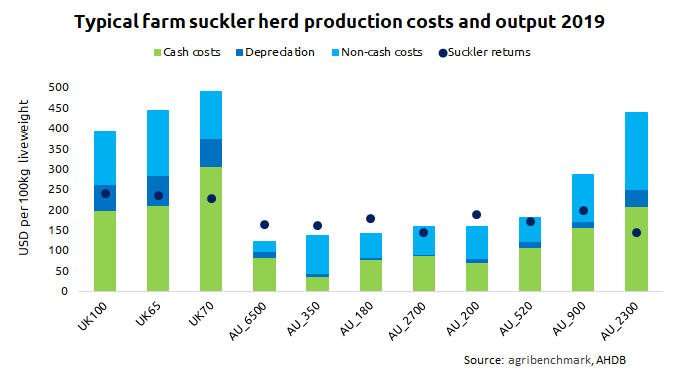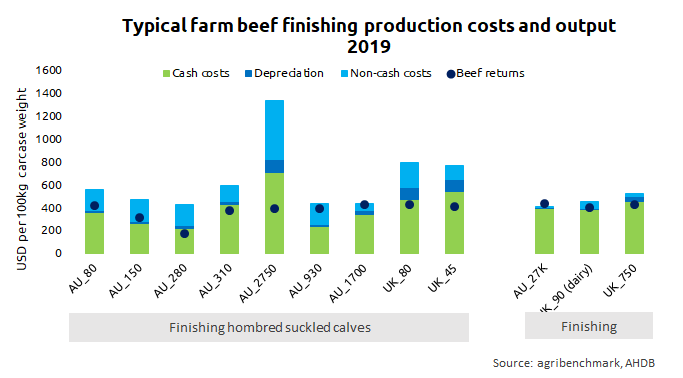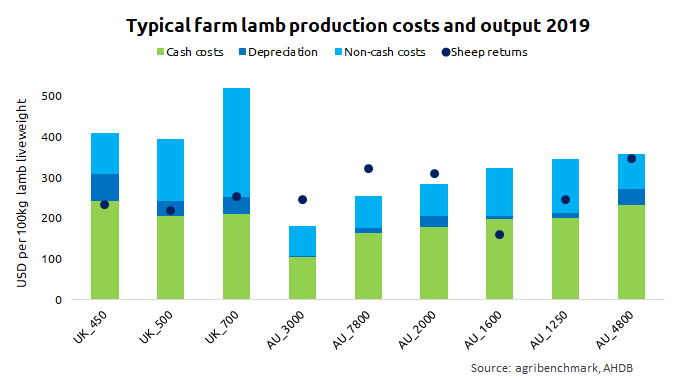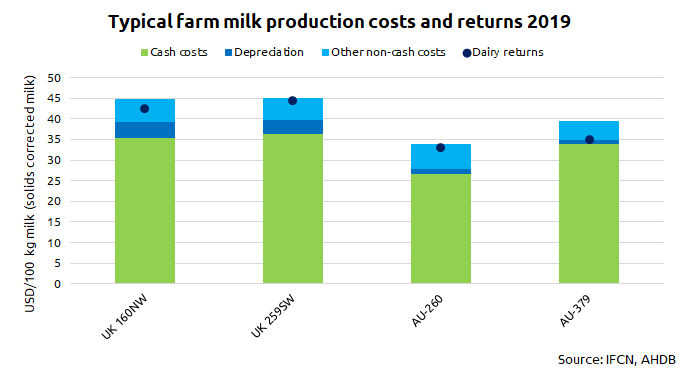Future trade deals: livestock production systems in Australia
Friday, 14 May 2021
Following on from our analysis of production trends and trade flows for Australian livestock products, in this article we take a more in depth look at how Australian livestock production systems compare to UK in terms of COP and how the various production systems actually function.
Introduction
For livestock systems, particularly those that are involved in meat and wool production, large climatic variations can have a large effect on how they are managed and stocked. For sheep and beef, a large proportion of farms will be extensively pasture based. Effects of prolonged periods of drought and seasonal bush fires can impact stocking levels, leading to an increased cost of production including the associated costs of de-stocking and restocking.
For beef and lamb comparisons, AHDB is a member of the international agri benchmark beef and sheep network (www.agribenchmark.org), a global, non-profit network of agricultural economists, advisors, producers and specialists in key sectors of agricultural.
The network uses internationally standardised methods to analyse farms, production systems and their profitability. There are over 30 countries in the network and each country has typical farms that illustrate the types of beef and sheep farms found in those countries. Depending on the size and variation of production systems, a country may have a number of typical farms.
Typical farms, as discussed below, are established in consultation with a focus group of farmers in the main areas of relevant production. Local farmers and advisors identify the typical size, enterprises, resources, inputs, outputs and operation of beef and sheep farms in a particular area.
Beef
Suckler cow systems are predominately pasture-based (sometimes plus silage) around the world – including Australia and the UK. In the UK, it would be typical for suckler cows to be housed during the winter. In Australia, it would be typical for there to be a lower reliance, and associated cost, with housing livestock.

A variety of beef suckler systems exist in Australia due to the variation of the country’s environment. Farms utilise Bos Indicus (zebu or humped cattle), Bos Taurus (more conventional type cattle from a UK perspective) as well as Brahman cattle, a breed which is a hybrid between the two cattle species and popular in Australia due to its high tolerance of heat, sunlight and humidity, with good resistance to parasites. Northern producers tend to favour Bos Indicus cattle for these reasons as well, although the beef quality of these animals is generally lower than Bos Taurus cattle, which are predominately farmed in the more southern areas of the country.
Australian suckler herds vary in size and management type. Herds with European type breeds tend to be smaller in herd size (180-500 head) with a lower age at first calving, calving around 24-26 months. On these types of herds, calves weaned per 100 cows is around 80-90.
Larger scale herds, in the region of 1000 head up to and above 6500 breeding females, tend to be more extensively managed and of Bos Indicus or Brahamn type cattle. Average age of calving is generally, but not exclusively, older than European type breeds at around 36-42 months at first calving. Calves weaned per 100 cows tend to be lower, around 60-80 on average, but can go down to nearer 50 in the larger scale herds.
Most breeding herds will finish at least a portion of youngstock on farm. However, a mix of finishing and selling as weanlings/stores is commonplace. On suckler farms that finish cattle, cattle are almost exclusively finished at pasture, along with some form of supplementation of hay, silage, concentrates or cottonseed etc.

Large-scale finishing units also exist in Australia. A typical unit would be finishing somewhere in the region of 27,000 head of cattle per annum purchasing predominately British Breeds and located near to the grain producing regions of Australia. The forage-based diet of the finishing cattle supplemented with grains and cottonseed. However, diets will vary depending on what market the cattle are intended for.
The use of growth promotors is permitted in Australia, for use in cattle destined for both the domestic market as well as other markets around the world. However, Australian cattle producers have various integrated assurance and traceability schemes to ensure that cattle destined for markets that prohibit growth promoters, such as the European market, are free from them and it enables Australia to meet specific market requirements. For instance, assurance schemes are also set up for the Chinese as well as other Asian markets.
Sheep
Australia is the world’s largest exporter of sheep products and as such has a large domestic industry. However, changes in demand for wool, which was a primary output for the Australia sheep industry pre-1990s, has resulted in a reduction of the domestic flock. Based on data from the Australia Bureau of Statistics, in 1990 the Australian flock numbered around 170 million head. By 2010, just 20 years later, the flock was around 68 million head, a 61% decline. Since then the flock has stabilised, but still fluctuates between 65-75 million, which will largely be influenced by weather patterns and prolonged drought.
Sheep production is located throughout Australia, although lamb production for slaughter is heavily concentrated in New South Wales and Victoria. A mix of farm types exist in the Australian sheep system, with some farms focussing solely on sheep production producing finished lamb for slaughter or wool. Other farms integrate sheep businesses, typically Merino X ewes, within arable rotations producing meat and some wool output. Sheep farms are pasture focused, with farms tending to be relatively extensive, especially in areas like Western Australia (WA) where flocks tend to be larger and sheep are run alongside other cash crops. Flock sizes in Australia tend to be larger than the typical UK farm (450-700 head) with a typical Australian farm having anywhere from 1,200 ewes in New South Wales, up to around 8,000 on some of the larger stations in WA. Wool is an important output to a number of farms and so many farms will keep wether lambs in order to get a wool crop from the sheep first before heading for meat production.

Australian farms typically have low machinery and building investment; ewes lamb outside, with the unpaid labour costs (often a family couple) spread across a large number of ewes. Production systems are more extensive and the lamb rearing percentage is lower than those typically achieved on many European farms. Australian sheep producers typically practice rotational paddock grazing, even on an extensive basis.
Dairy
Over the past 30 years, the Australian dairy industry, like many other sectors in Australian agriculture, have been subject to major policy reforms. This has been aimed at deregulation and reducing producer price support mechanisms, which will be discussed in more detail in a future article. However, this has resulted in a major structural change in the ways farms operate and produce milk. These structural changes mean that the number of farms has reduced, while the size of individual farms increased. Similar to the UK, the number of dairy farmers in Australia have been on the decline as increased economies of scale and more exposure to the global market occurs. The number of dairy farmers in Australia was 5,055 in 2019/20 (Dairy Australia), down from around 8,055 in 2006/7.

Dairy farming occurs in all Australian states, however production is predominately confined to the South East of the country, which has a climate more suited to growing grass. Typical farms in Australia are herds with between 260-380 milking cows. Diets are predominately grass based (either fresh or silage or hay), supplemented with cereal based concentrates. In a normal year, around 60-65% of a dairy cow’s diet will come from grazing and dairy farms in Australia are typically dairy specialists (only dairy as an enterprise). Due to the drier climate, some inland farms choose to irrigate pasture land to ensure a reliable growing season but in periods of extreme drought, use of irrigators is not guaranteed and so production even on irrigated farms is still impacted. Like the UK, Holstein Friesians are a typical breed in the Australian dairy system with yields around 6200-7300kg milk.
Pork
The pork industry in Australia is comparatively quite small when compared to Australia’s other red meat sectors. However, it is the 2nd most consumed meat in Australia and consumption is growing. Like the UK, Australia runs three distinct types of pig farming systems:
- Indoor systems – these make up around 90% of Australia’s pigs. Both sows and rearing pigs are housed for their entire life. Around 80% of the sows housed indoors are in loose housed systems.
- Outdoor bred system – these make up around 5% of Australia’s pigs. Pigs are born and raised up until weaning in an outdoor system, at which point they are transferred to large indoor, deep littered straw barns. This system has a recognised accreditation scheme. Outdoor systems are rotated in conjunction with cereal or forage-based crops.
- Free range system – these make up around 5% of Australia’s pigs. Sows and reared pigs are kept outdoors for their entire life, with access to sufficient shelter with the paddock. Like outdoor systems, paddocks are rotated in conjunction with other crops. Free-range systems are relatively uncommon in Australia, due to predators and climatic factors, resulting in indoor systems, where the environment and predation from animals can be better controlled, potentially being better from a welfare perspective in Australia.


